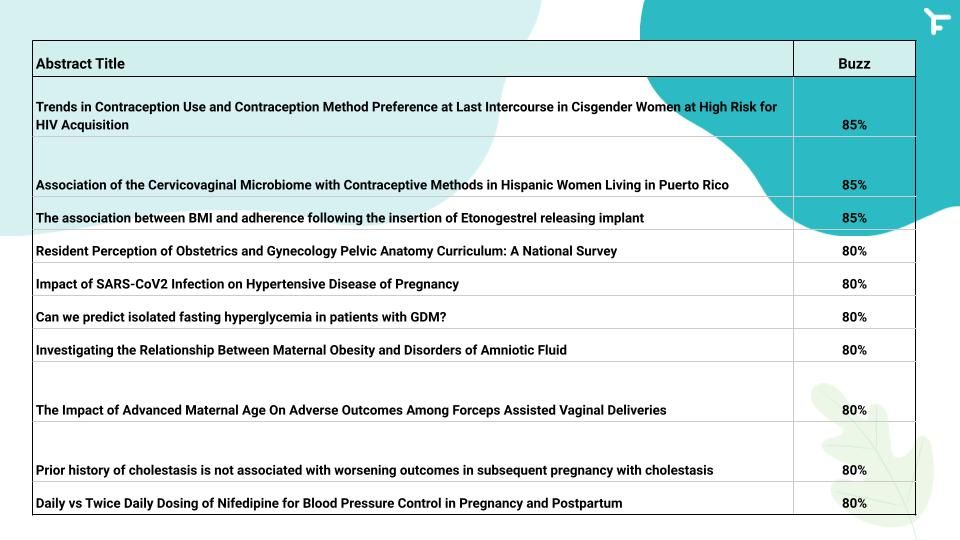ACOG 2023: A Recap of the Leading Conference in Women's Healthcare!

American College of Obstetricians and Gynecologists (ACOG) 2023, the prestigious conference dedicated to advancing the field of obstetrics and gynecology has taken place from May 19th at Baltimore, MD and has come to the end on May 21st via an in-person model with the mission of supporting their members to improve the lives of all people seeking obstetric and gynecologic care, their families, and communities.
Ferma.AI has analyzed all 1,000 abstracts presented at the conference, along with social media activity and news reports to determine the most relevant and high-impact sessions for obstetricians and gynecologists. The sessions that garnered the most attention covered a diverse range of content including cutting-edge research, new treatments and therapies and insights into the latest clinical practices.
Interested in learning more about how Ferma.AI can enhance your conference coverage and insights while also reducing costs by 40%? Schedule a brief call with us to see a live demonstration.
High-Impact Sessions
Here are the 10 paramount sessions that left an indelible mark on obstetricians and gynecologists.

Let's delve into the essential insights gained from these sessions:
Trends in Contraception Use and Contraception Method Preference at Last Intercourse in Cisgender Women at High Risk for HIV Acquisition
Session Type: ePoster
Buzz Score: 85%
[Abstract]
This study examines contraception use during the last intercourse in cisgender women at high risk for HIV acquisition. There was no significant difference in contraception use at last intercourse between women at high and low risk (P=.262, OR 1.11 [0.93–1.32]). Among non-users, those at risk for HIV acquisition cited indifference towards pregnancy (P=.029, OR 1.79 [1.06–3.01]) and method lapse (P=.001, OR 4.55 [1.80–11.5]) as reasons. High-risk individuals were more likely to have used an intrauterine device (P<.001, OR 1.70 [1.28–2.24]) and less likely to have used hormonal shots (P=.015, OR 0.47 [0.26–0.86]).
Association of the Cervicovaginal Microbiome with Contraceptive Methods in Hispanic Women Living in Puerto Rico
Session Type: ePoster
Buzz Score: 85%
[Abstract]
This study assessed the impact of different contraceptive methods on the cervical microbiome of Hispanic females in Puerto Rico. An analysis of 85 women aged 21-45, categorized based on their contraceptive method, revealed that male condoms and sterilization correlated with higher microbiome richness, while IUDs and female sterilization were associated with greater microbiome diversity. Birth control pills and male condoms had minimal effects on the microbiota, showing a predominance of Lactobacillus. Injectable progesterone and IUD use were linked to increased levels of Gardnerella, and the IUD group exhibited notable presence of Clostridium compared to other groups. Female sterilization correlated with abundant Atopobium and Streptococcus, while the injectable progesterone group showed elevated levels of Megasphaera.
The association between BMI and adherence following the insertion of Etonogestrel releasing implant
Session Type: ePoster
Buzz Score: 85%
[Abstract]
This study aimed to investigate the association between body mass index (BMI) and side effects/adherence to etonogestrel-releasing implant treatment. The study included 1,318 women, with 35% requesting early removal of the implant. Irregular bleeding was the primary reason for early removal. The early removal group had a lower rate of obesity (BMI ≥30 kg/m2), while side effects were more prevalent in non-obese women. Regression analysis indicated that side effects were the only significant predictor of early implant removal. BMI did not significantly impact treatment adherence.
Resident Perception of Obstetrics and Gynecology Pelvic Anatomy Curriculum: A National Survey
Session Type: ePoster
Buzz Score: 80%
[Abstract]
This study aimed to assess the perspective of ob-gyn residents on their residency's pelvic anatomy curriculum through a national survey. Out of 582 possible residents from 28 responding programs, 180 (31.0%) residents participated. The majority were aged 25-34 (95.5%), identified as female (86.1%), and belonged to academic programs (69.4%). Only 58.1% received formal education on pelvic anatomy, while 77.5% had formal surgical simulation. Though 88.8% had protected lecture time, only 62.9% found the lectures educational. Residents who had formal education and surgical simulation felt better trained in obstetrics and gynecology (P<.05). A hands-on anatomy program should be considered to improve training in pelvic anatomy for ob-gyn residents.
Impact of SARS-CoV2 Infection on Hypertensive Disease of Pregnancy
Session Type: ePoster
Buzz Score: 80%
[Abstract]
This study aimed to examine the impact of gestational SARS-CoV-2 infection on the risk of developing pregnancy-induced hypertension (PIH). The study included 307 participants from the Generation C prospective cohort study in New York City. Among the participants, 27% (n=84) had SARS-CoV-2 infection during pregnancy, but none experienced moderate symptoms or required hospitalization. Of those exposed to SARS-CoV-2, 12% (n=10) developed any hypertensive disease of pregnancy. However, in adjusted models, there was no significant association between gestational SARS-CoV-2 infection and PIH (OR 0.53, 95% CI [0.22, 1.16], P=.13). This diverse prospective study challenges recent findings suggesting an increased risk of PIH in pregnancies with antenatal SARS-CoV-2 infection, particularly in cases of asymptomatic or mild infection.
Can we predict isolated fasting hyperglycemia in patients with GDM?
Session Type: ePoster
Buzz Score: 80%
[Abstract]
The study aimed to identify risk factors for predicting fasting hyperglycemia in patients with gestational diabetes mellitus (GDM). Among 405 GDM patients, 57% had GDMA1 and 28% had GDMHS. Higher HbA1c at GDM diagnosis (OR 3.55), older age (OR 1.08), and higher fasting glucose tolerance test (GTT) value (OR 1.06) were significantly associated with increased probability of persistent fasting hyperglycemia. Asian race was associated with decreased probability, confounded by lower fasting GTT and BMI.
Investigating the Relationship Between Maternal Obesity and Disorders of Amniotic Fluid
Session Type: ePoster
Buzz Score: 80%
[Abstract]
This retrospective cohort study of 966 women aimed to determine the association between late-pregnancy obesity and amniotic fluid disorders. There was no significant association between oligohydramnios and increasing BMI, including overweight and different obesity classes. The same was true for polyhydramnios. Elevated maternal BMI did not show a significant association with amniotic fluid disorders, regardless of obesity severity.
The Impact of Advanced Maternal Age On Adverse Outcomes Among Forceps Assisted Vaginal Deliveries
Session Type: ePoster
Buzz Score: 80%
[Abstract]
The objective of this study was to evaluate the association between advanced maternal age (AMA) and obstetric anal sphincter injury (OASIS) rates in forceps-assisted vaginal deliveries (FAVDs). The study included 983 records, with 704 non-AMA and 279 AMA patients. AMA patients did not show increased odds of OASIS compared to non-AMA patients (OR 1.21 [0.78, 1.89]). There were no significant differences in quantitative blood loss, NICU admission, or adverse neonatal outcomes between the two groups. AMA does not appear to be a risk factor for OASIS or adverse outcomes in FAVDs.
Prior history of cholestasis is not associated with worsening outcomes in subsequent pregnancy with cholestasis
Session Type: ePoster
Buzz Score: 80%
[Abstract]
This study aimed to determine whether a prior pregnancy complicated by intrahepatic cholestasis of pregnancy (IHCP) is associated with more severe adverse outcomes in a subsequent pregnancy with IHCP. Among 795 multiparous pregnancies with IHCP, 23.3% had a prior history of IHCP. Pregnancies with a prior history of IHCP had higher rates of prior preterm birth, earlier gestational age at diagnosis and delivery, and greater use of ursodeoxycholic acid therapy. However, after adjusting for confounders, the association with iatrogenic preterm birth and NICU admission was not statistically significant. There was no significant association between prior IHCP history and other adverse obstetric outcomes.
Daily vs Twice Daily Dosing of Nifedipine for Blood Pressure Control in Pregnancy and Postpartum
Session Type: ePoster
Buzz Score: 80%
[Abstract]
This study compared the effectiveness of 60 mg QD versus 30 mg BID of extended-release nifedipine for blood pressure control in 237 patients. There was no significant difference in the need for increased dosage or additional antihypertensive medications between the groups. Emergency hypertensive treatment and readmission for blood pressure control did not differ between the two dosing regimens. These results suggest that daily dosing is reasonable and convenient for patients.
Wrap-up
Ferma.AI tracks abstract and data releases for all major healthcare conferences, alongside social media and healthcare news reactions. Interested in learning more about how Ferma.AI can enhance your conference coverage and insights while also reducing costs by 40%? Schedule a brief call with us to see a live demonstration.

